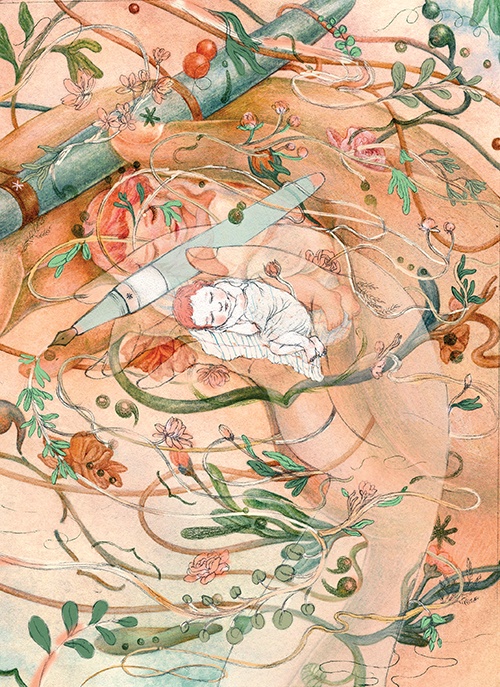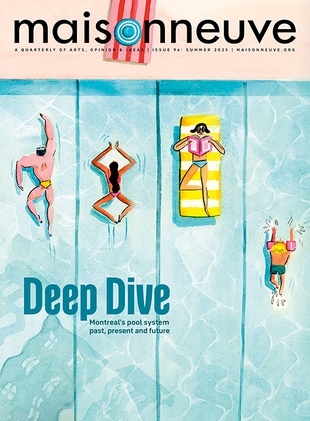 Illustration by Sous Sous.
Illustration by Sous Sous.
Crib Notes
Gavin Andrew Thomson reads Rivka Galchen’s Little Labors, reflecting on writers who mother and mothers who write.
“LITERATURE HAS MORE DOGS THAN BABIES,” Rivka Galchen writes in her latest book, Little Labors, “and also more abortions.” It’s an observation that’s somehow both surprising and obvious. Of course, writers can’t do much with a character who’s an infant. A baby can’t talk. A baby can’t stand. A baby mostly cries and eats and crawls and poops and sometimes sucks its toe or plays with a rattle. “The human baby is like no other baby animal,” Galchen argues, quoting a friend’s mother. “The animals can at least walk, while the human baby is a nothing.”
When infants do appear in books, they tend to carry baggage: a struggling couple chooses to have a baby in the hopes that it will save their marriage; a woman’s desire to have (or not have) a baby triggers a crisis in her partner. “One might say that most babies in literature,” writes Galchen, “when they appear for more than a moment, tend to be catalysts of decay or despair, as surely now and again babies in real life are.” If literature teaches anything, it’s that having a baby is a bad idea.In many cases, it seems like writers’ aversion to babies is personal. To be a serious writer, the thought goes, one has to be what novelist Jenny Offill calls an “art monster”: someone who dedicates him or herself utterly to their craft at the expense of all else—specifically, children. As critic Cyril Connolly once wrote, “There is no more sombre enemy of good art than the pram in the hall.”
Yet this line of thinking is beginning to change. In Little Labors, Galchen pens a series of thoughtful essays that deal with all things baby. Perhaps most importantly, Galchen shows how raising a baby might actually make a writer’s work better. Galchen is not alone in this regard; she is part of a web of contemporary authors who are demonstrating, against tradition, that writing and childrearing can go hand in hand—if not literally (“I cannot hold my baby at the same time as I write,” Maggie Nelson says in The Argonauts), then, at least, in more abstract ways.
NOT LONG AGO, Galchen, author of the novel Atmospheric Disturbances and the collection of short stories American Innovations, gave birth to a daughter. After having her daughter, whom she christens “the puma” in Little Labors, Galchen started noticing things she’d previously ignored: movie posters, the shape of infants’ heads, the ubiquity of the colour orange. “All the banal (or not) objects and experiences around me,” she writes, “were re-enchanted.” Rather than robbing Galchen of her curiosity in the world, her baby augmented it. “The puma,” she writes, was “a near mute force” that imbued the quotidian with fresh new marvels, “so that the world seemed ludicrously, suspiciously, adverbially sodden with meaning.”
It is precisely these small, previously hidden marvels that Galchen details in the essays that make up Little Labors. Topics are motley—dinosaurs, poor representations of babies in Renaissance art, ronin—but “the puma” serves as the nucleus around which Galchen orbits, allowing her to remain loyal to her central themes: babies and art and babies in art.
A highlight of the book is the way in which Galchen investigates well-known texts and films for depictions of infants where, it turns out, they’ve been hiding all along. She reads the titular Godzilla, for example, not as a threatening monster but as a big angry baby: “Godzilla is a child-like creature, innocent of his destruction. Even above-ground Godzilla walks widely, like a toddler.” Better, Galchen reads Mary Shelley’s Frankenstein as “the story of an infant angry about being born at all, a half-rhyme emotionally with the book itself being termed by its mother/author to be her ‘hideous progeny’—a phrase more sad than flip, as Mary Shelley knew herself to be the progeny whose arrival led to the death of her mother, Mary Wollstonecraft, the vindicator of the rights of women.”
As a physical product, Little Labors is slim and fragmented. The book is a mere 130 pages, comprising fifty-six essays. In this way, the book connotes how caring for a baby deprives its mother the time and energy to compose sustained passages; it implies how a baby in the house forces its mother to write in quick, fugitive bursts between maternal duties (changing the baby, feeding the baby, bathing the baby, burping the baby), thus drawing the reader’s attention to the myriad little emotional labours that most writers hide or ignore. While reading, one gets the sense of both the author’s hand at work and her baby’s interfering with it—grasping for her pen, tugging on her sock, crying until Galchen looks away from her laptop. It’s as though “the puma” co-authored the book with Galchen, precisely by depriving Galchen of the time and attention she needed to write.
THE LITERARY WORLD is full of inattentive—and downright absent—parents. There’s Ernest Hemingway, whose daughter Gloria (née Gregory) once wrote: “When it’s all added up, papa, it will be: he wrote a few good stories, had a novel and fresh approach to reality and he destroyed five persons—Hadley, Pauline, Marty [Martha Gellhorn, Hemingway’s third wife], Patrick and possibly myself.” There’s Wallace Stevens, who once deemed parenthood a “terrible blow to literature.” It’s a lengthy list that Galchen partially catalogues in one of the most guiltily entertaining sections of her book. A dark highlight:
Doris Lessing: Left two of her three children to be raised by their father. Later semi-adopted a teenage girl, a peer of one of her sons. Said … there was “nothing more boring for an intelligent woman than to spend endless amounts of time with small children.”
Galchen turns this notion of parenthood-as-trap on its head (she writes that her daughter made her “more like a writer,” precisely by transforming her into “someone who was, enduringly, not writing,”) and she goes on to name her peers who are starting to see family in a similar vein. Galchen describes Elena Ferrante, Sarah Manguso, Karl Ove Knausgaard and, “in his way,” Louis C.K. as fellow artists who are writing about babies in a “genre we recognize as literature.”
In Sarah Manguso’s memoir Ongoingness, she positions her baby as the focal point of her attention, detailing how her son alters her phenomenological experience of time. And in The Argonauts, Maggie Nelson investigates, among other conundrums, how her son troubles her understanding of theory: “I don’t want an eros, or a hermeneutics, of my baby,” she writes. “Neither is dirty, neither is mirthful, enough.”
Together, by treating babies as ripe sites of meaning and not, as tradition would have it, the diapered foe of literature, these writers are inducing a paradigm shift, gently rocking the canon like a cradle. Instead of shutting down creativity by forcing a choice between book and baby, these writers have embraced parenthood as a doubly generative act.
IN THE ARGONAUTS, Nelson recalls an awkward scene that took place at a seminar where art critic Rosalind Krauss told English academic Jane Gallop that the latter’s recent practice of photographing her son had “punted on the most basic aesthetic concepts of art history.” Krauss’s tacit argument, according to Nelson, was that Gallop’s maternity had “rotted her mind—besotted it with the narcissism that makes one think that an utterly ordinary experience shared by countless others is somehow unique, or uniquely interesting.”
Yet what Little Labors proves is precisely how such an utterly ordinary experience can indeed seem unique—and uniquely interesting—if the writer is ingenious enough to render it as such. As Galchen adeptly demonstrates, the pram in the hall is no longer the sombre enemy of good art—ignoring it is.





